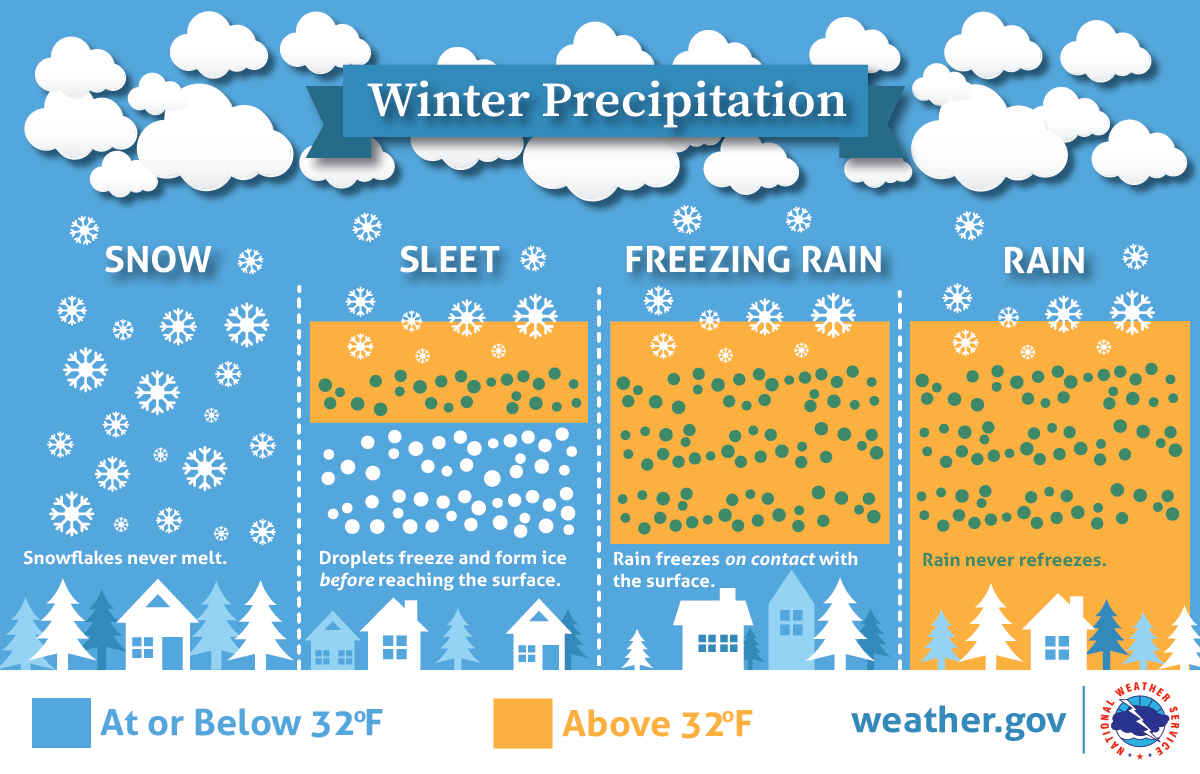Please help the National Weather Service spread these important safety messages on social media! Everyone is welcome to use the text and images provided below to help the NWS build a Weather-Ready Nation.
Facebook
Prepared for a possible polar plunge? As temperatures drop, remember to protect the 4 P’s: People, pets, pipes, and plants. weather.gov/safety/cold
Twitter
Prepared for a possible polar plunge? As temperatures drop, remember to protect the 4 P’s: People, pets, pipes, and plants. weather.gov/safety/cold
#WeatherReady
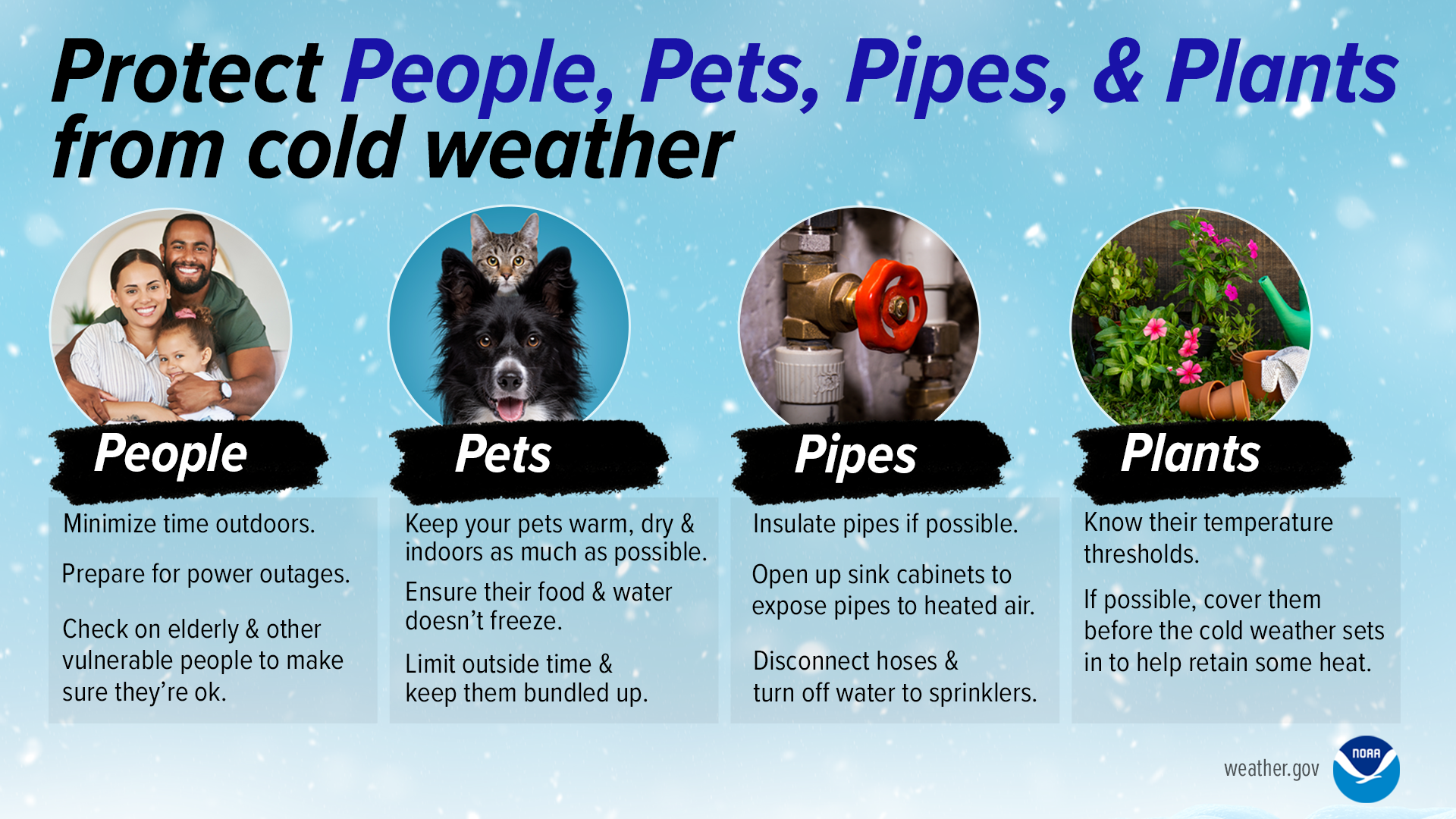
Facebook
Cold outside? Avoid the risk of frostbite and hypothermia by dressing in layers, covering exposed skin, and limiting time outdoors. If someone might be experiencing either condition, seek medical attention immediately — and know your actions. weather.gov/safety/cold-during
Twitter
Cold outside? Avoid the risk of frostbite and hypothermia by dressing in layers, covering exposed skin, and limiting time outdoors. If someone might be experiencing either condition, seek medical attention immediately — and know your actions. weather.gov/safety/cold-during
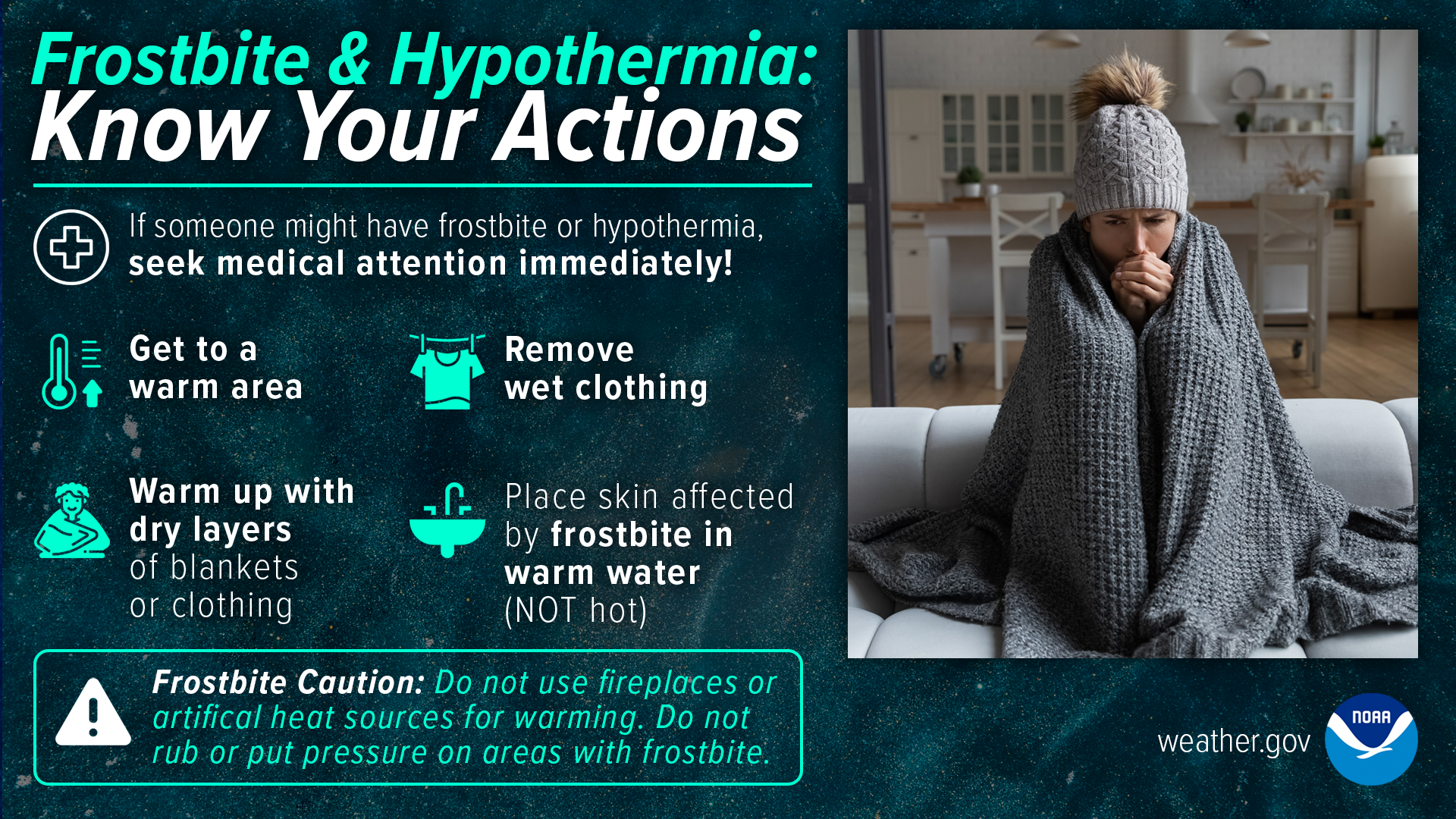
Facebook
Slipping on an icy sidewalk can lead to serious injuries or even death, especially for the elderly. Help prevent the formation of ice by salting walkways and turning off sprinklers in advance of cold weather.
Learn more ice safety at weather.gov/safety/winter-ice-frost
Twitter
Slipping on an icy sidewalk can lead to serious injuries or even death, especially for the elderly. Help prevent the formation of ice by salting walkways and turning off sprinklers in advance of cold weather.
Learn more ice safety at weather.gov/safety/winter-ice-frost #WeatherReady
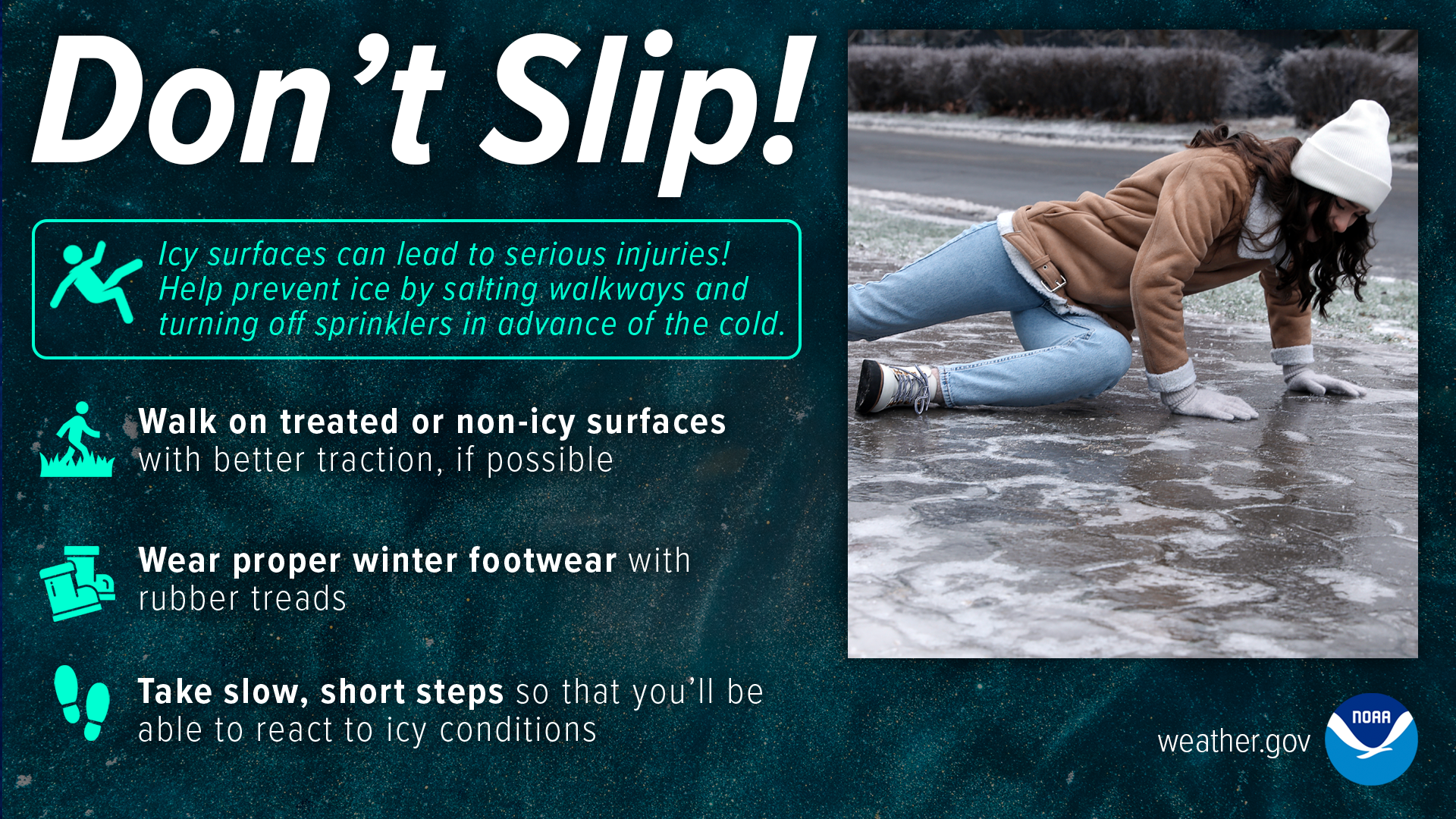
Facebook
Sleet can be deceptively dangerous - it’s much more dense than snow, so take it easy when shoveling.
Use extreme caution when driving during or after sleet. Reduce speed, allow plenty of stopping distance, and do not use cruise control.
Learn more winter safety at weather.gov/safety/winter
Twitter
Sleet can be deceptively dangerous - it’s much more dense than snow, so take it easy when shoveling.
Use extreme caution when driving during or after sleet. Reduce speed, allow plenty of stopping distance, and do not use cruise control.
weather.gov/safety/winter #WeatherReady
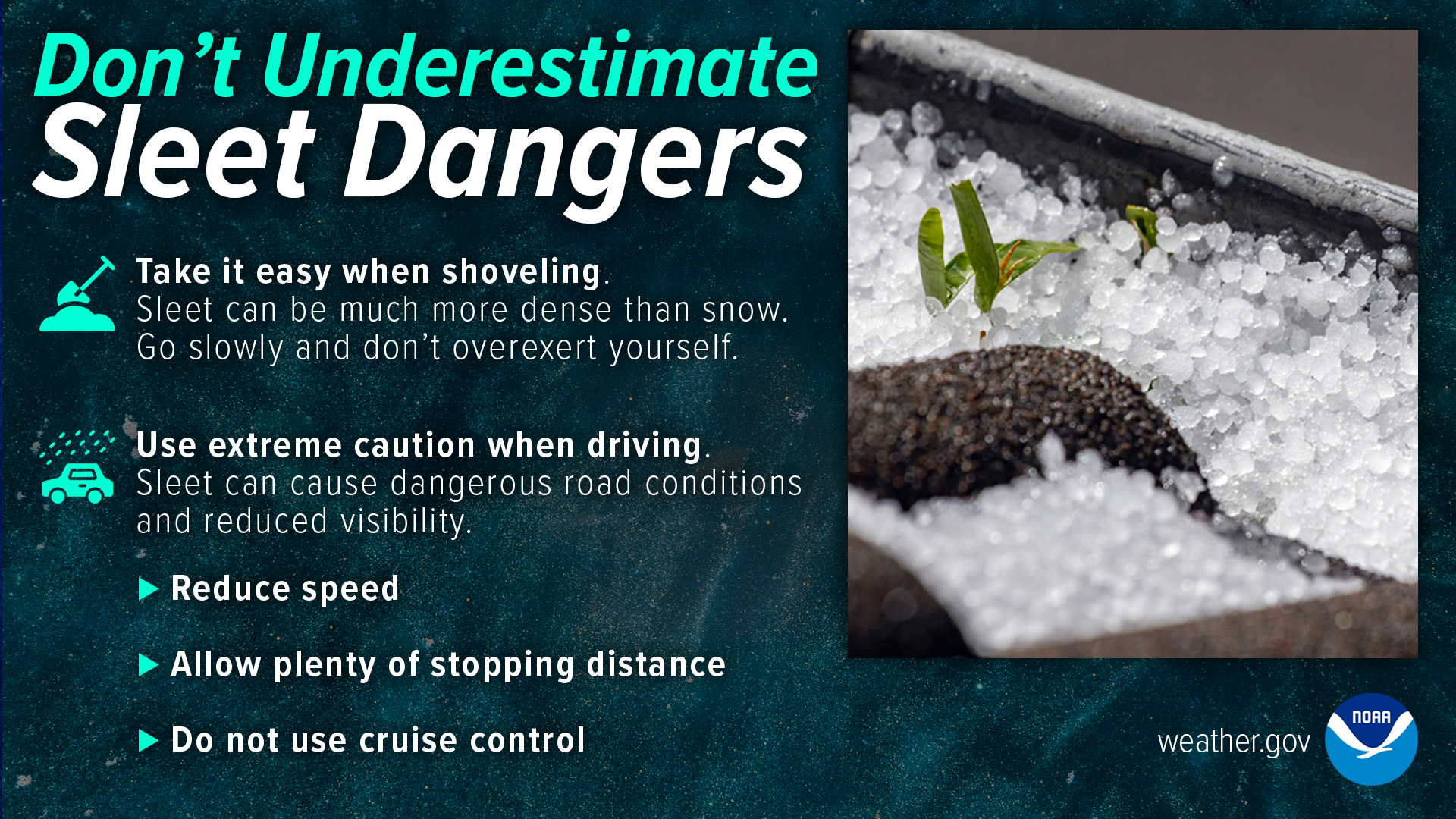
Facebook
Everyone is at risk from the dangers of extreme cold, but these groups are more vulnerable than most. Age and certain conditions make the body less able to regulate temperature.
Stay Weather-Ready and learn more about cold safety at weather.gov/safety/cold
Twitter
Everyone is at risk from the dangers of extreme cold, but these groups are more vulnerable than most. Age and certain conditions make the body less able to regulate temperature.
Stay #WeatherReady and learn more about cold safety at weather.gov/safety/cold
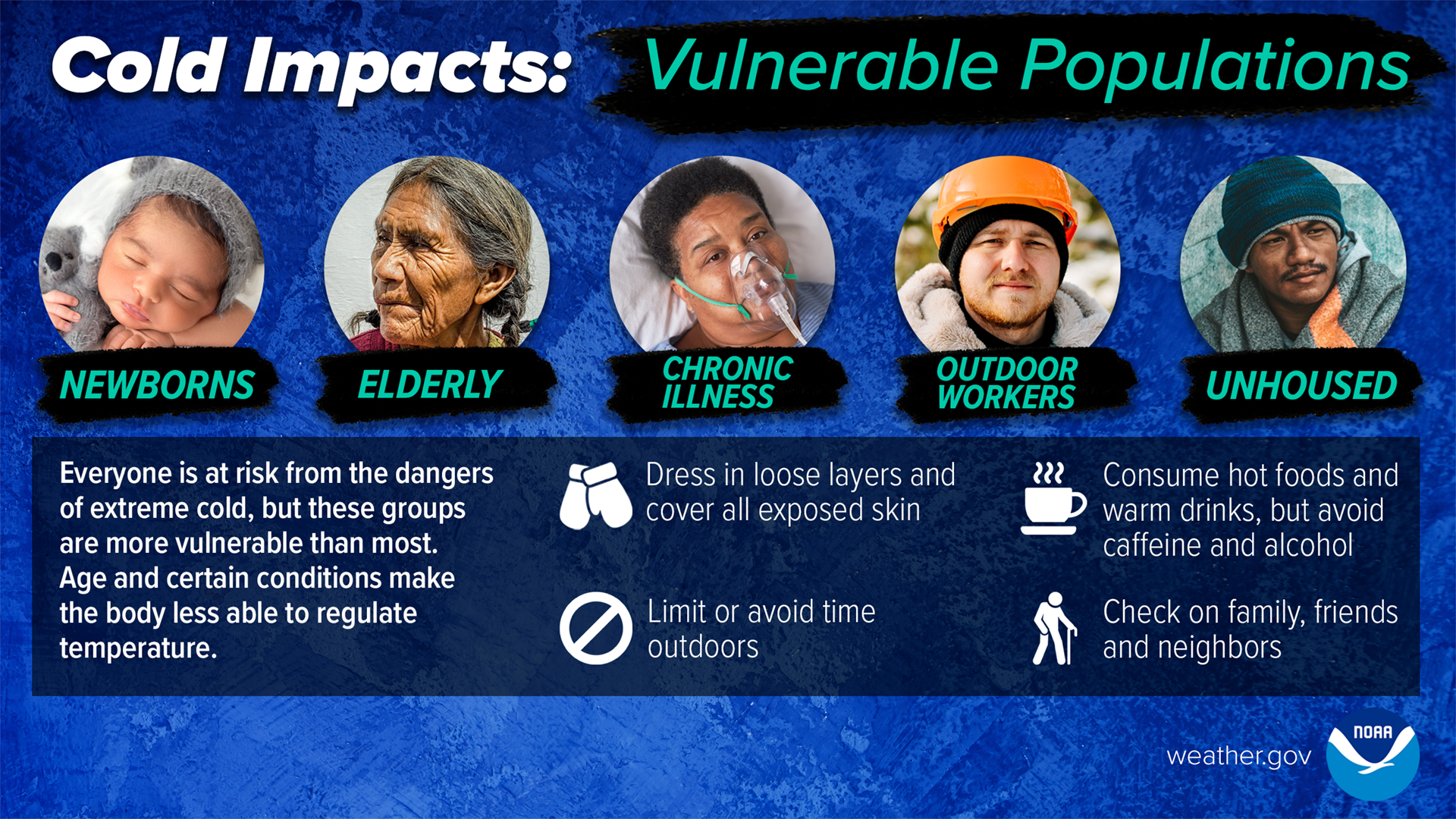
Facebook
Are you prepared for a winter storm? If the forecast calls for winter weather, begin preparing NOW. Don’t wait until the last minute. weather.gov/safety/winter-before
Twitter
Are you prepared for a winter storm? If the forecast calls for winter weather, begin preparing NOW. Don’t wait until the last minute. weather.gov/safety/winter-before #WeatherReady
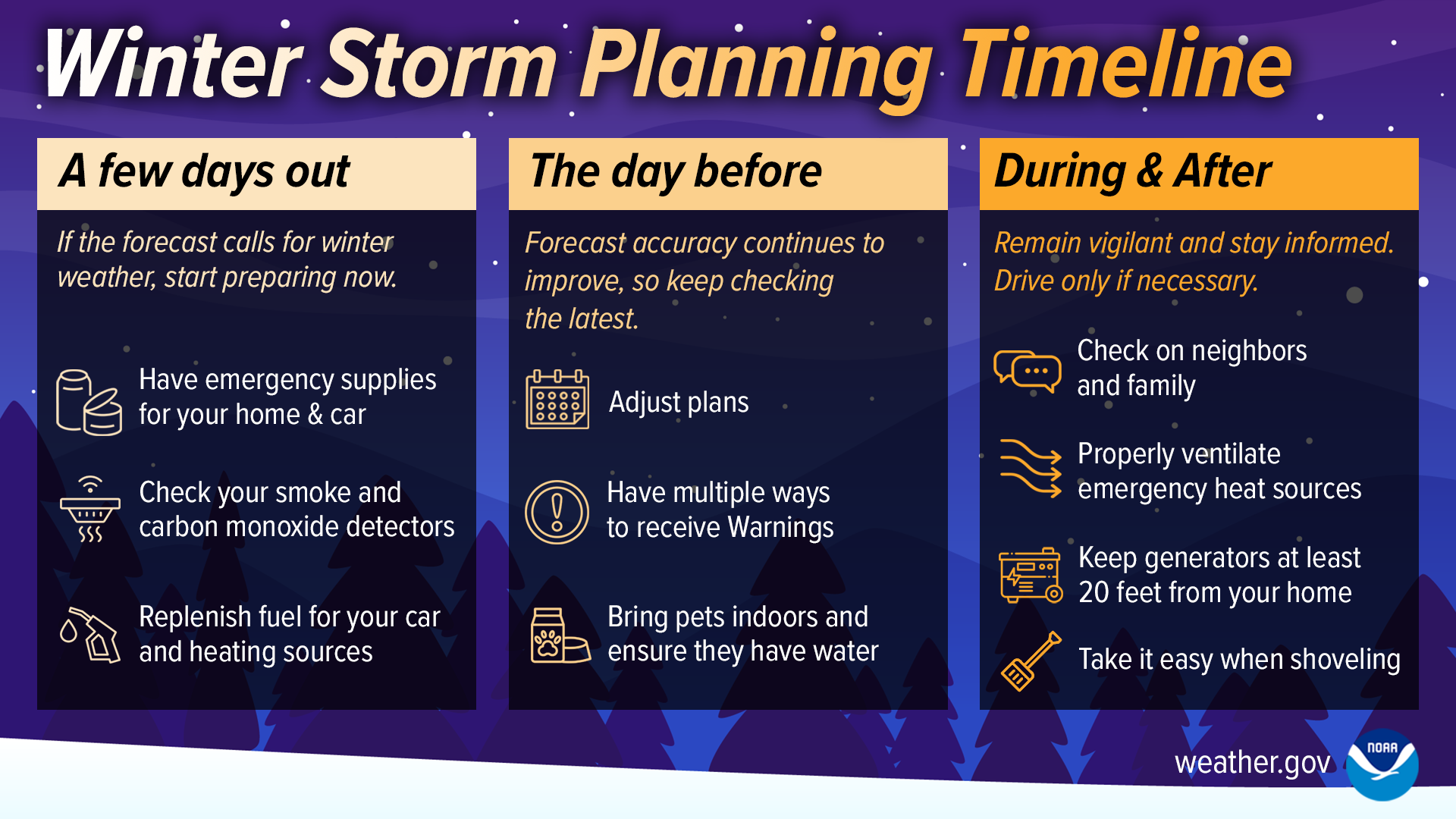
Facebook
Winter driving can be hazardous. Slow down to keep yourself and everyone on the road safe. Remember, “Ice and snow, take it slow”. Learn more at weather.gov/safety/winter
Twitter
Do your part to keep everyone safe on the roads this winter. Learn more at weather.gov/safety/winter
#WeatherReady
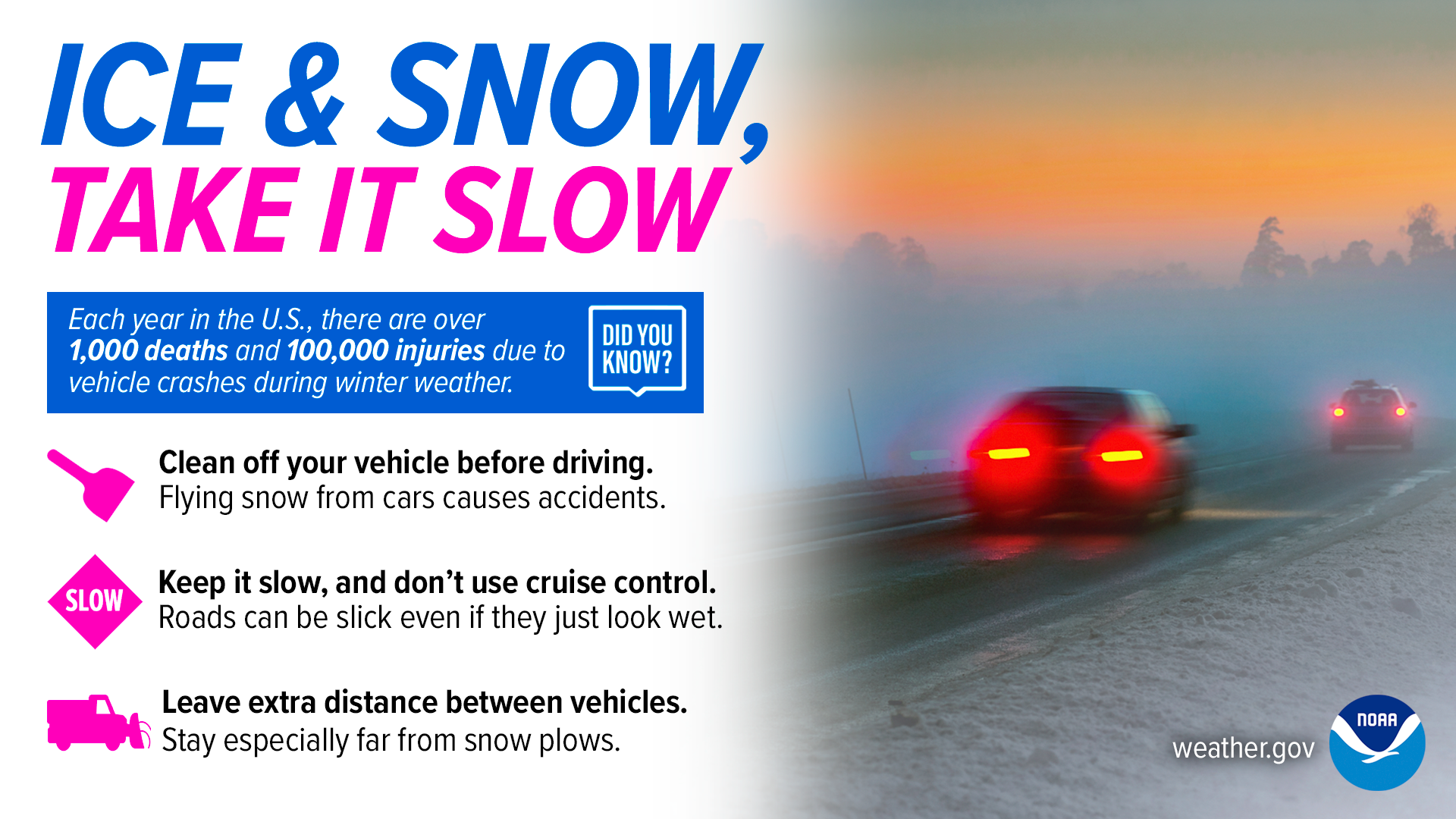
Facebook
During a snow squall, the last place you want to be is on the road.
Delay travel if a snow squall warning is issued. If you’re caught on the road when a snow squall occurs, use extreme caution. Slow down, turn on your low-beams and hazards, and pull over safely to the side of the road, remaining in the vehicle with the seatbelt on.
weather.gov/safety/winter-snow-squall
Twitter
During a snow squall, the last place you want to be is on the road.
Stay #WeatherReady by delaying travel if there’s a snow squall warning.
If you’re caught on the road when a snow squall occurs, use extreme caution.
weather.gov/safety/winter-snow-squall
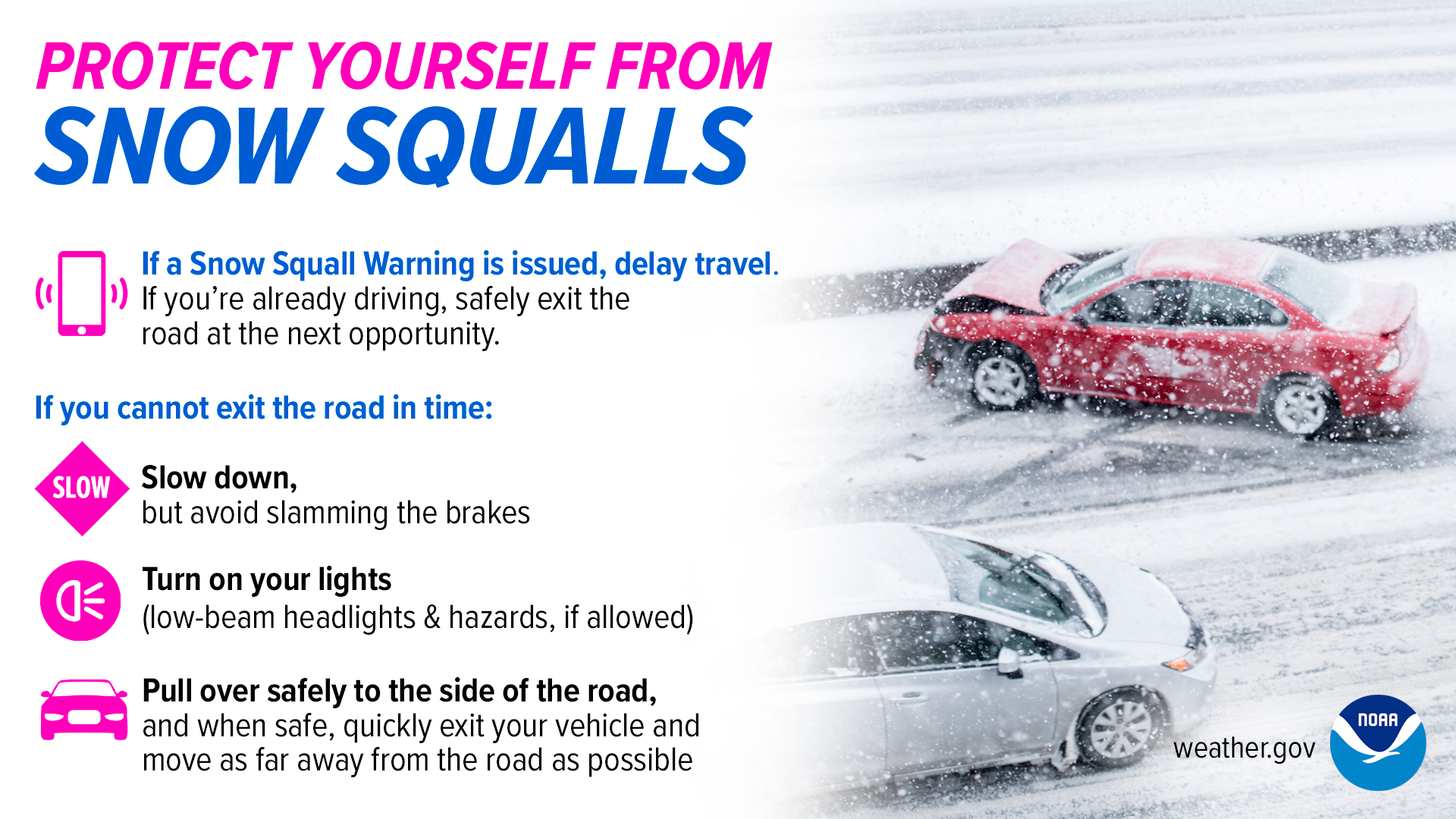
Facebook
Don't forget about your pets this winter! Make sure they have a warm, dry place to rest with plenty of food and water. weather.gov/winter
Twitter
You love your pets, so keep them warm, dry, and well fed this winter. weather.gov/winter #WeatherReady
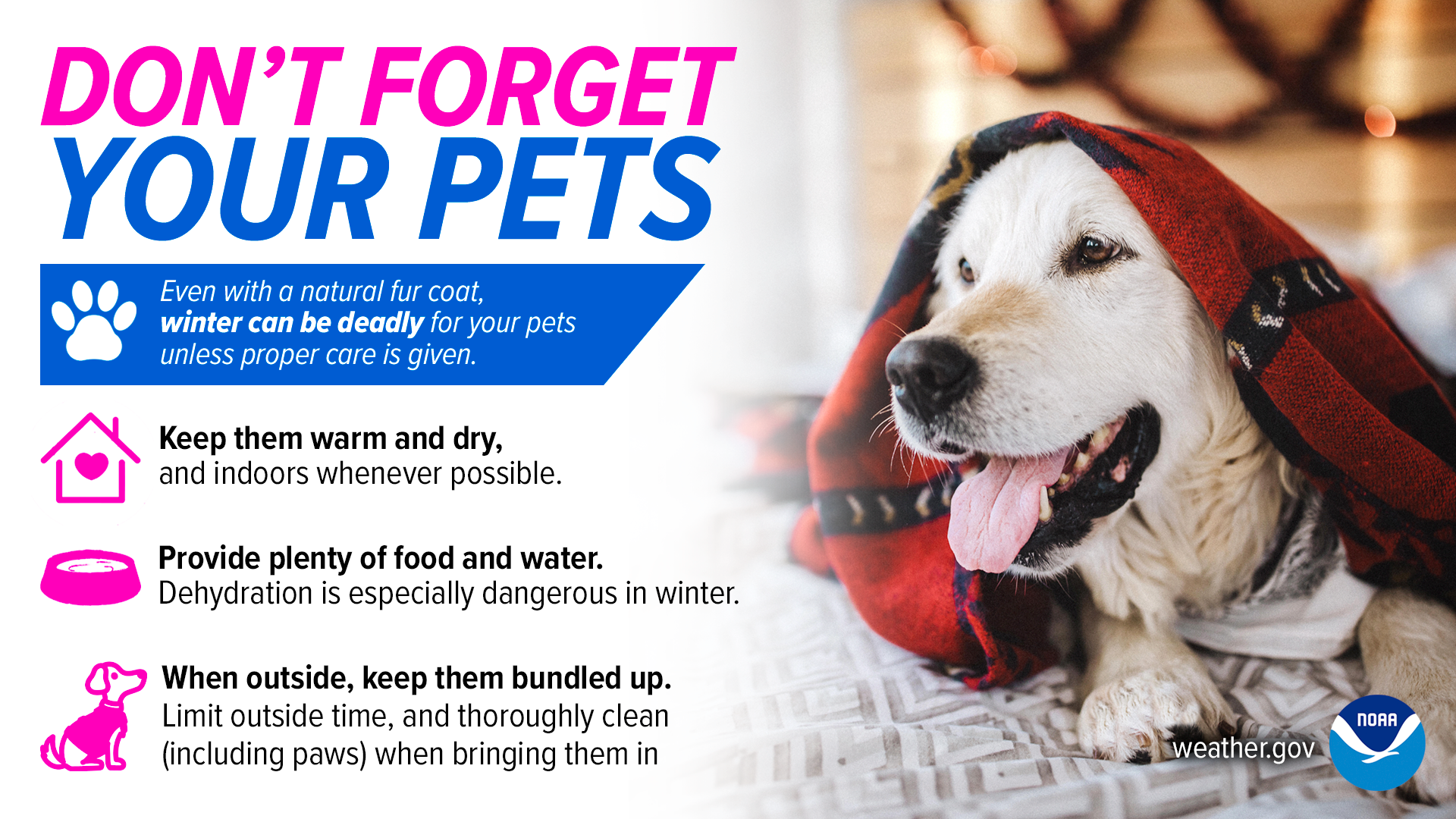
Facebook
Slippery sidewalks and roads aren’t the only things to look out for in late winter and early spring snow storms--shoveling snow can be a health risk as well. Remember to stay hydrated, take frequent breaks, and move only small amounts with each shovel pass. Learn more at weather.gov/winter
Twitter
Shoveling snow can be a health risk, so remember to take it easy. Learn more at weather.gov/winter #WeatherReady
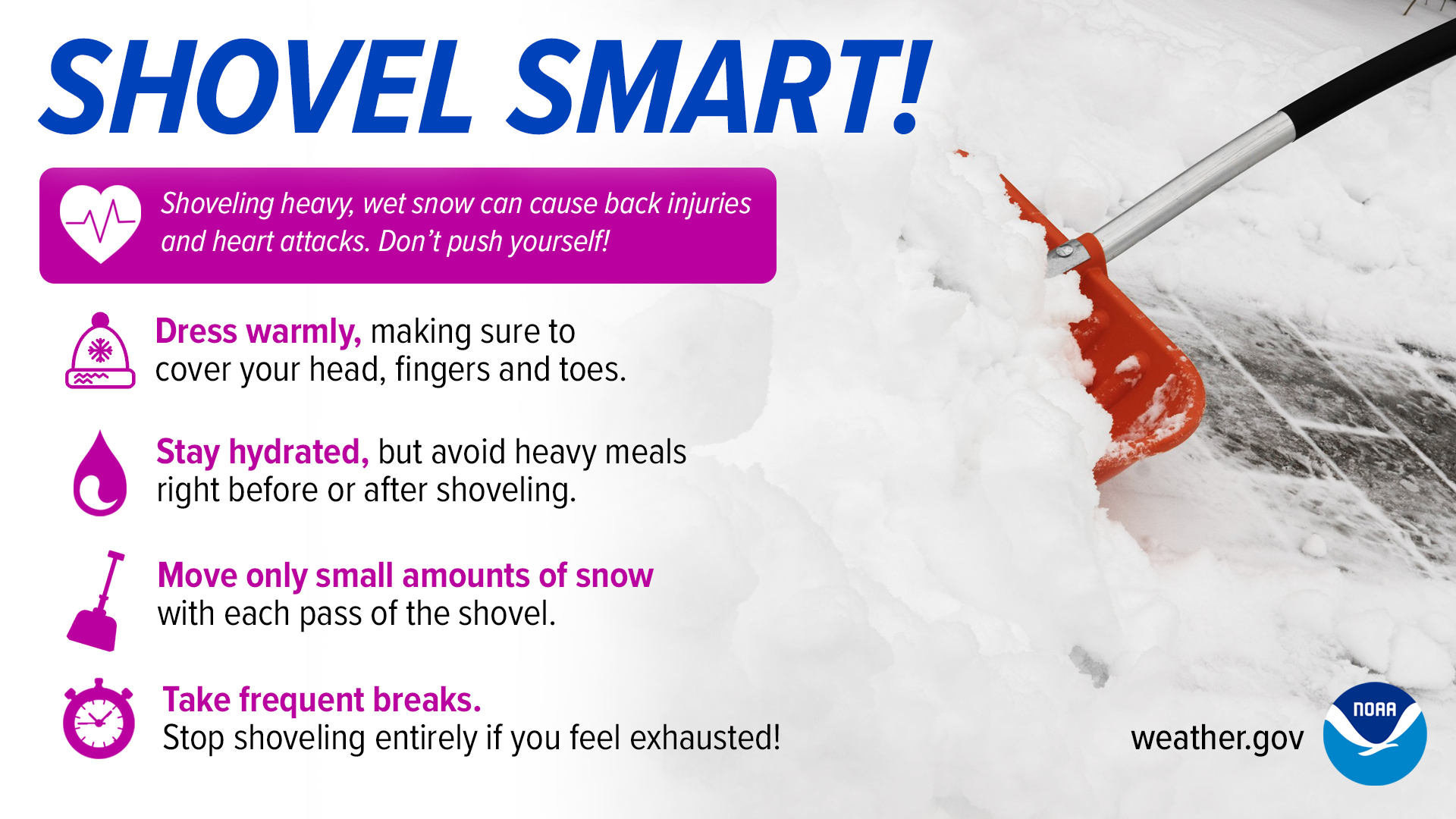
Facebook
When caught outdoors in a winter storm, there are life-saving actions you can take to protect yourself. Find (or make) shelter, cover exposed body parts, melt snow for drinking water, and exercise occasionally. weather.gov/safety/winter-during
Twitter
When caught outdoors in a winter storm, there are life-saving actions you can take to protect yourself. #WeatherReady
weather.gov/safety/winter-during
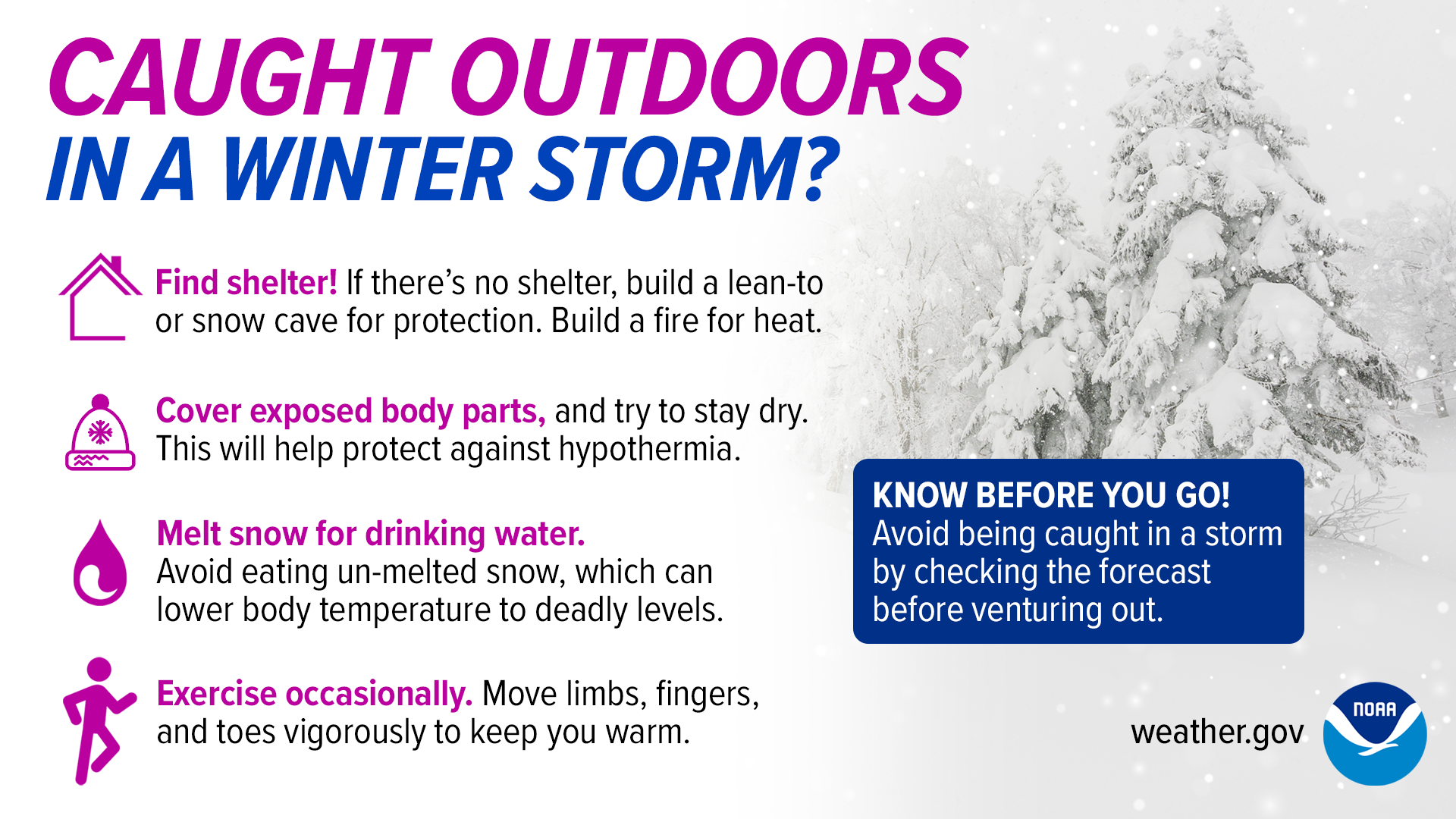
Facebook
As winter approaches, there are steps you can take to prepare your home for the cold weather ahead. Learn more at weather.gov/safety/winter
Twitter
As winter approaches, there are steps you can take to prepare your home for the cold weather ahead. Learn more at weather.gov/safety/winter
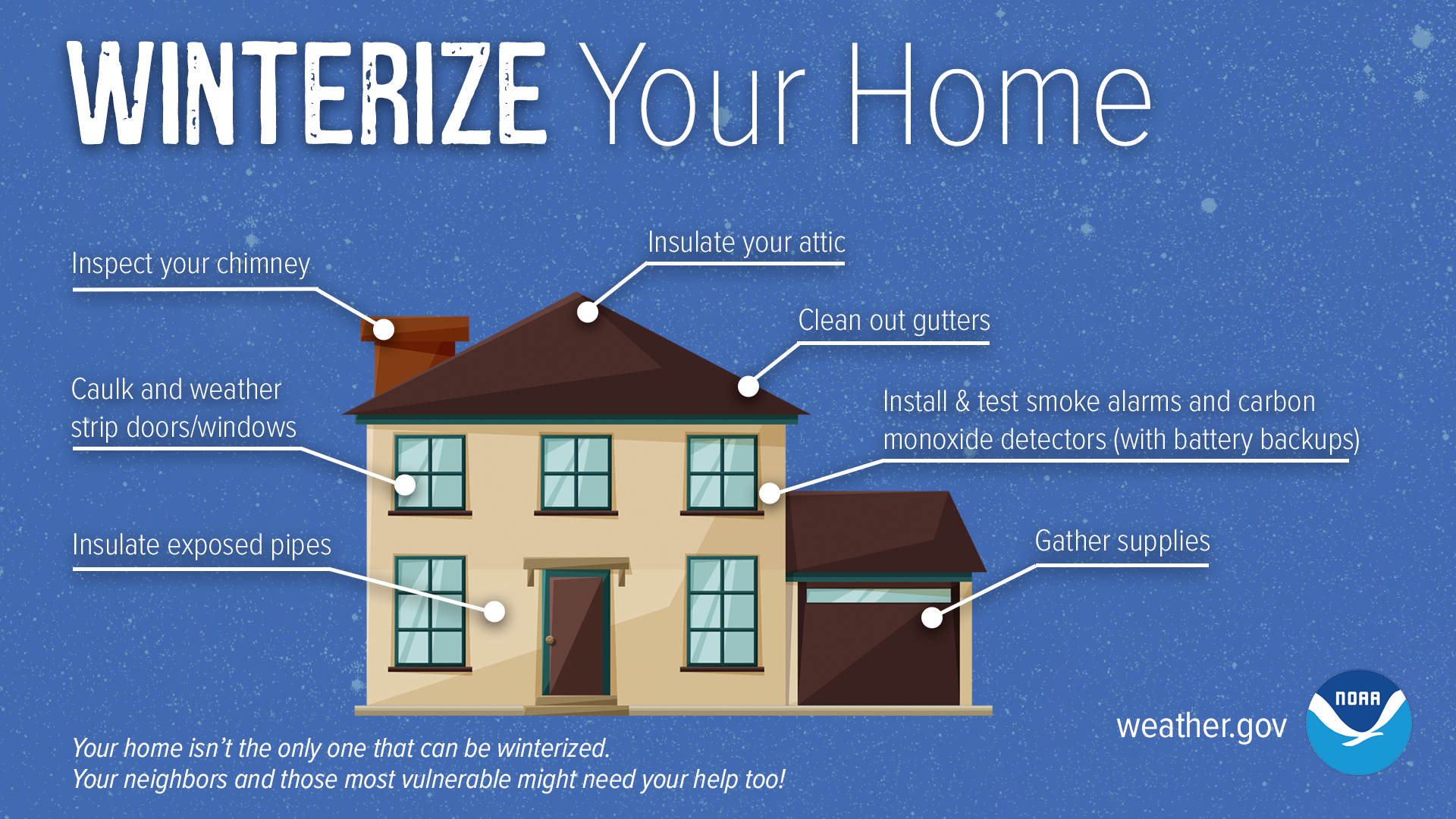
Facebook
Power outages are common after a big winter storm. If you lose power, make sure to be careful when using alternative heat sources and practice portable generator safety. Once you and your family are safe, check in with others in your neighborhood to make sure they are okay. weather.gov/safety/winter
Twitter
Power outages are common after a big winter storm. Be careful with alternative heat sources, practice portable generator safety, and check in with neighbors to ensure that everyone stays safe. weather.gov/safety/winter
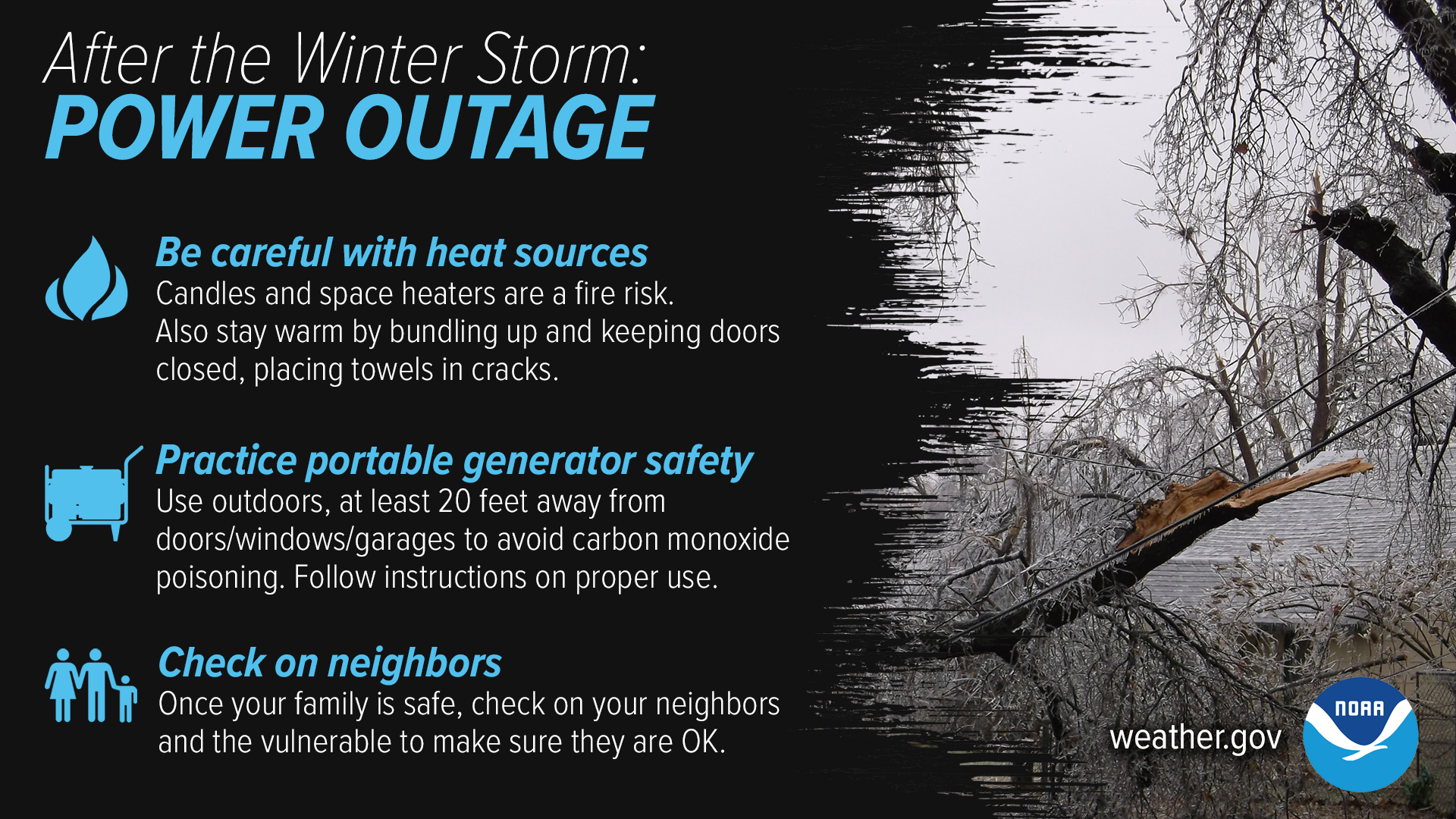
Facebook
Did you know that a one or two degree temperature difference can play an important role in whether we get rain, sleet, or snow? Learn more about how we get accurate forecasts here: youtube.com/watch?v=niPqFAtq8_E
Twitter
Did you know that a one or two degree temperature difference can play an important role in whether we get rain, sleet, or snow? Learn more about how we get accurate forecasts here: youtube.com/watch?v=niPqFAtq8_E
Facebook
Impacts from winter storms can vary a lot, even across short distances, and it can be difficult to pinpoint exactly which areas will be most impacted. Learn more about the Winter Storm Severity Index here: youtube.com/watch?v=u_rLZicceTc
Twitter
Impacts from winter storms can vary a lot, even across short distances, and it can be difficult to pinpoint exactly which areas will be most impacted. Learn more about the Winter Storm Severity Index here: youtube.com/watch?v=u_rLZicceTc
Facebook
We work hard to provide you with the most accurate forecasts possible, and our forecasts get more precise the closer we get to a big weather event. Learn more about how we update our forecasts at youtube.com/watch?v=O19o47qWdSE
Twitter
We work hard to provide you with the most accurate forecasts possible, and our forecasts get more precise the closer we get to a big weather event. Learn more about how we update our forecasts at youtube.com/watch?v=O19o47qWdSE
Facebook
A Winter Storm WATCH means Be Prepared.
A Winter Storm WARNING means Take Action!
weather.gov/safety/winter-ww
Twitter
A Winter Storm WATCH means Be Prepared.
A Winter Storm WARNING means Take Action!
weather.gov/safety/winter-ww #WeatherReady
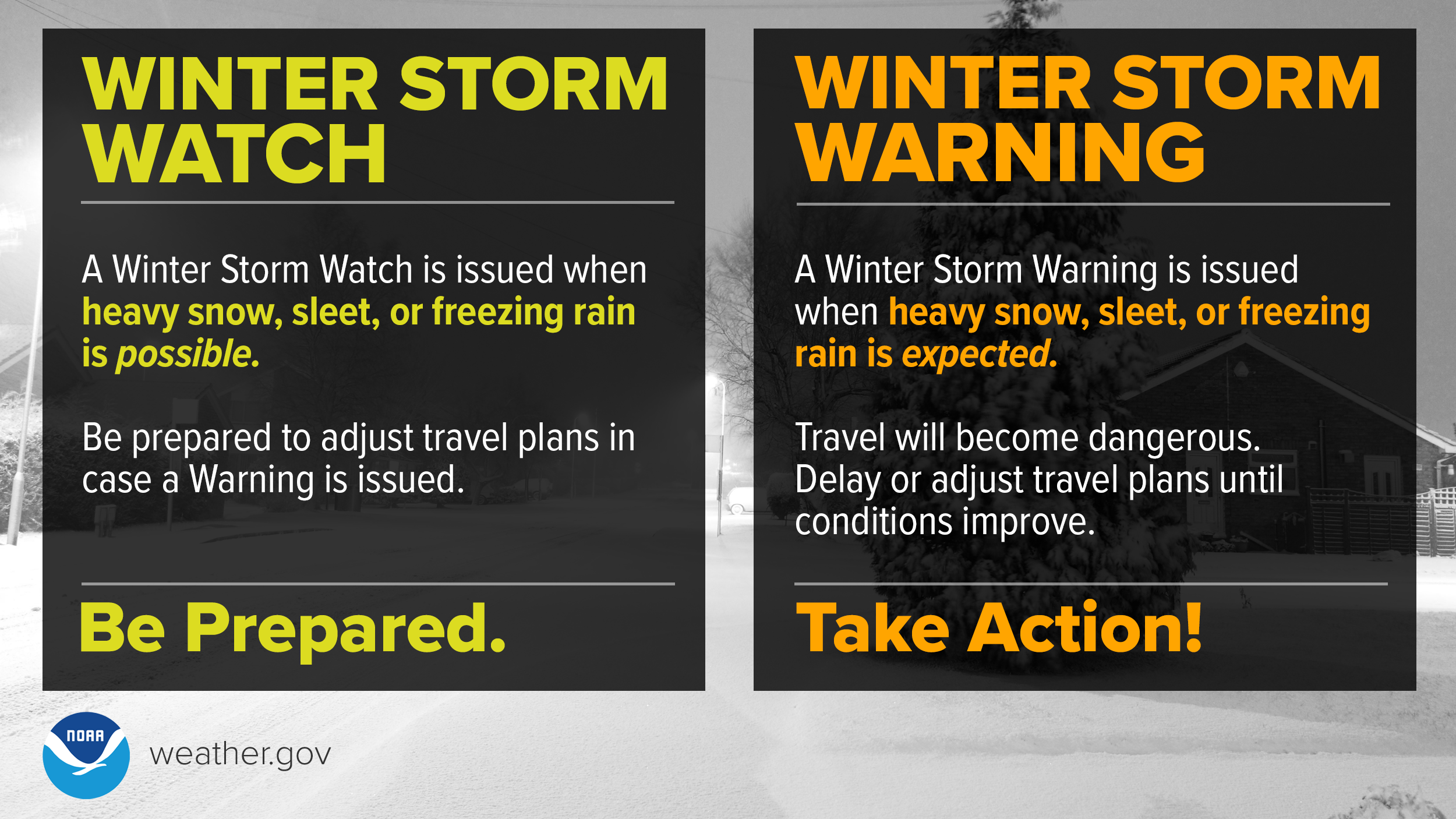
Facebook
For those working outside during cold temperatures or winter weather, stay Weather-Ready and prepared. osha.gov/dts/weather/winter_weather/
Twitter
For those working outside during cold temperatures or winter weather, stay #WeatherReady and prepared. osha.gov/dts/weather/winter_weather/
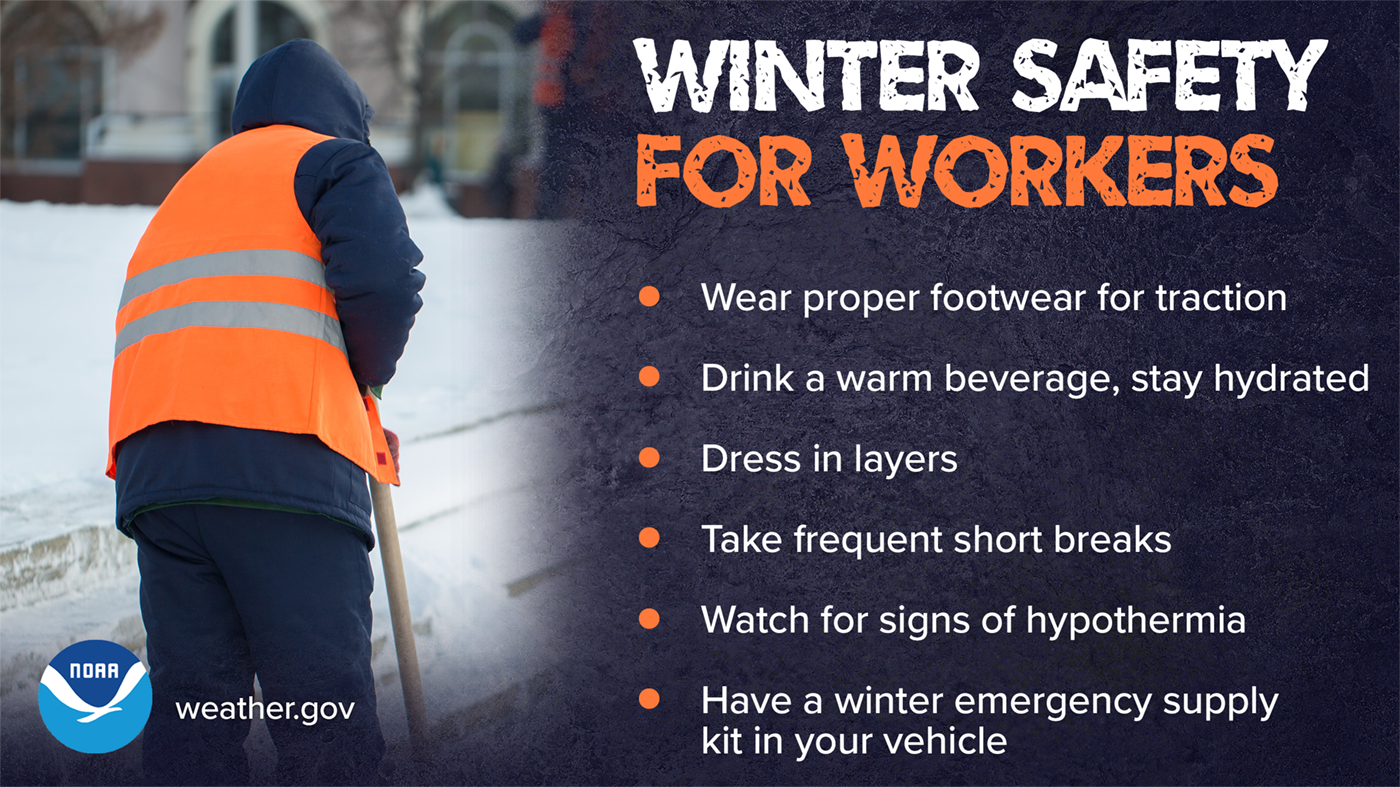
Facebook
A Wind Chill WATCH means Be Prepared.
A Wind Chill WARNING means Take Action!
weather.gov/safety/cold
Twitter
A Wind Chill WATCH means Be Prepared.
A Wind Chill WARNING means Take Action!
weather.gov/safety/cold
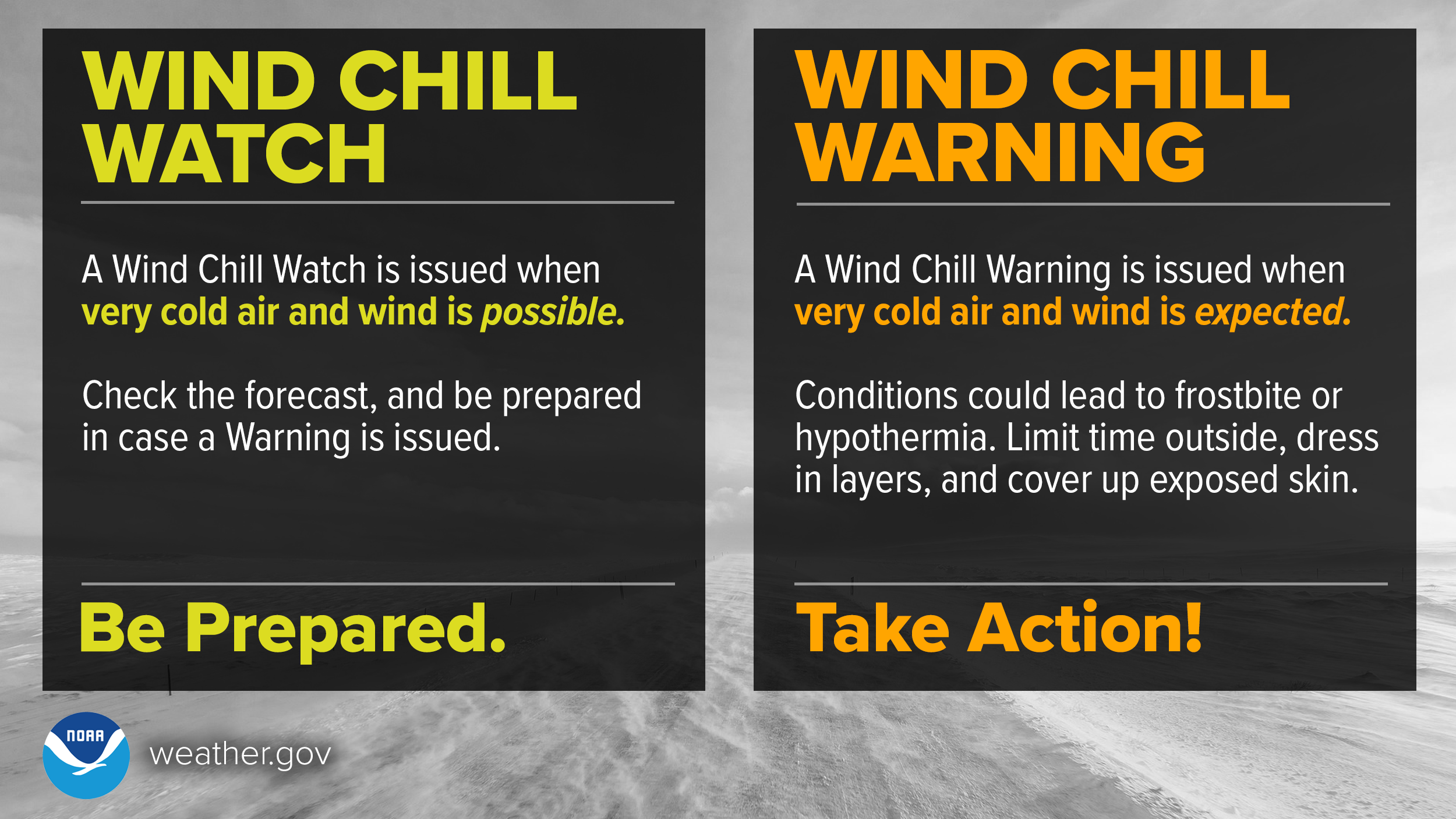
Facebook
Is your home ready for an ice storm? Ice storms can cause power outages that can last up to several days, affecting both you and the surrounding area — that’s why it’s important to have a week’s supply of food and prescriptions. What else would you need?
Ice storms can easily break tree branches, so trim weak or damaged branches around your home, and don’t park your car under trees. After you’ve parked, don’t leave your wipers raised...contrary to popular belief, doing so increases the chance of wiper damage.
Learn more about ice storm safety: weather.gov/safety/winter-ice-frost
Twitter
Is your home ready for an ice storm? Ice storms can cause power outages that can last several days and pose a threat to tree branches and anything underneath. Stay #WeatherReady and learn more about ice storm safety: weather.gov/safety/winter-ice-frost
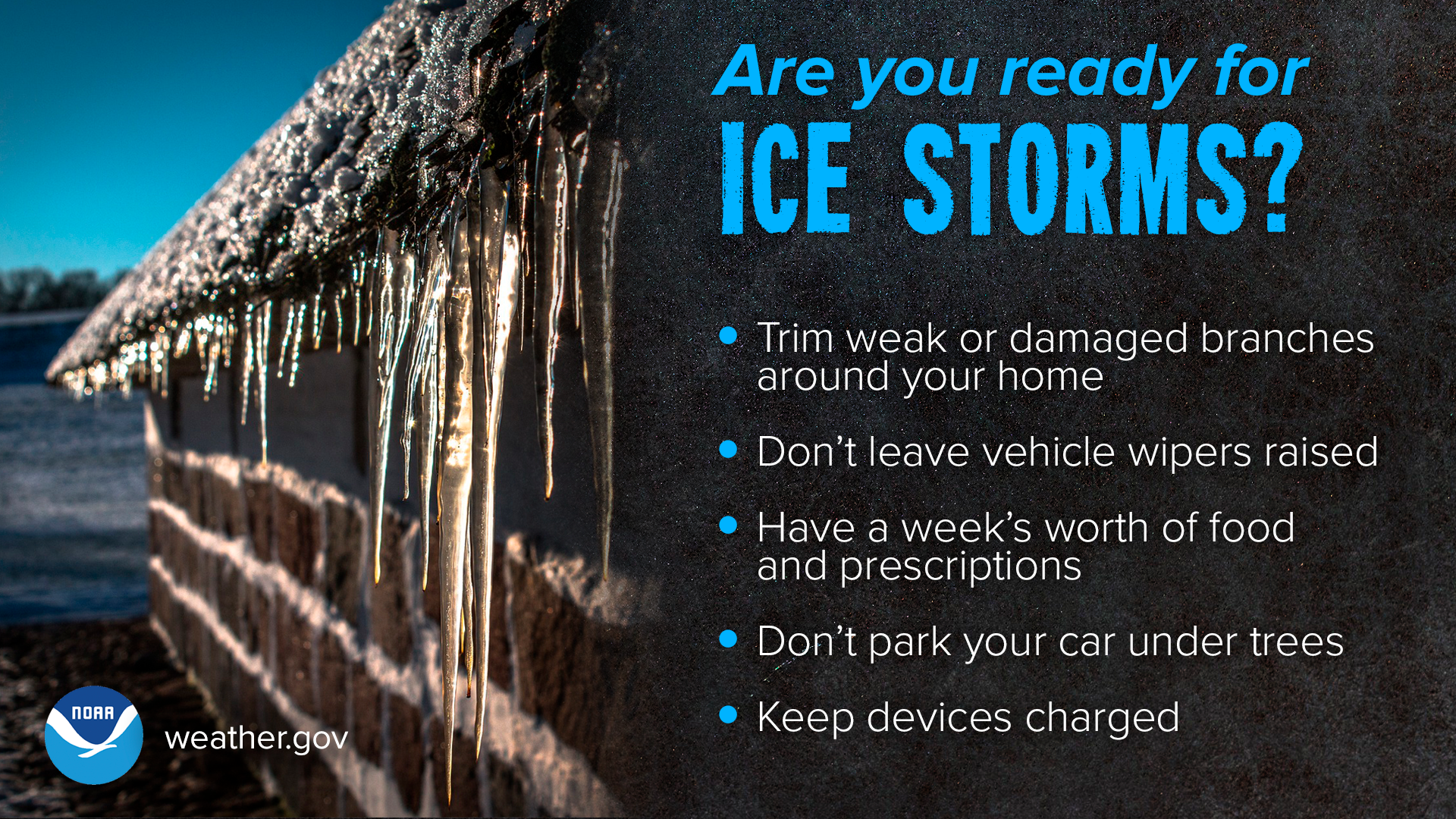
Facebook
When the power goes out in winter, the cold can be deadly--but even without power, there are still ways to warm things up. Closing blinds and curtains and closing room doors can help contain heat, and stuffing towels in the cracks under doors can help keep the warmth in. Don’t forget about eating and staying hydrated - food provides energy to warm the body.
Learn more about winter safety: weather.gov/safety/winter
Twitter
When the power goes out in winter, the cold can be deadly. But even without power, there are still ways to warm things up. Stay #WeatherReady and learn more about winter safety: weather.gov/safety/winter
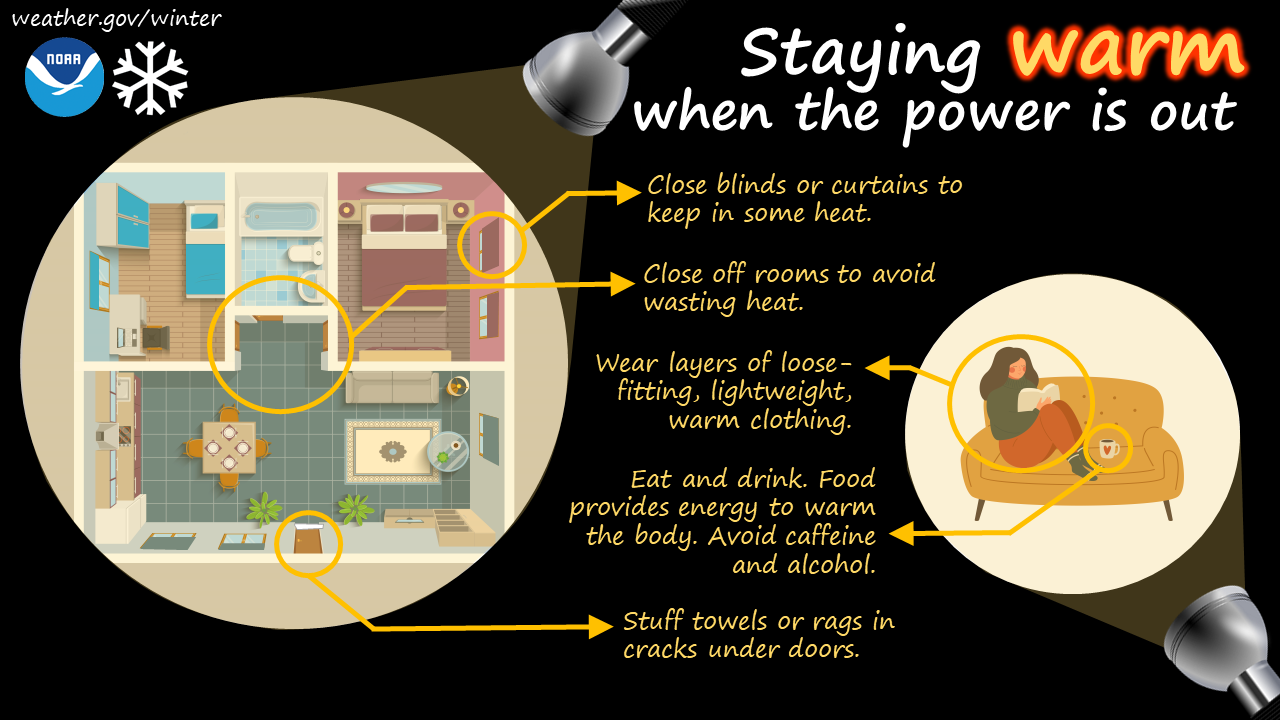
Facebook
Ice is never completely safe. Know how thick the ice is and stay away from any cracks or melting ice. If you don’t know, don’t go! weather.gov/safety/winter
Twitter
Ice is never completely safe. Know how thick the ice is and stay away from any cracks or melting ice. If you don’t know, don’t go! weather.gov/safety/winter #WeatherReady
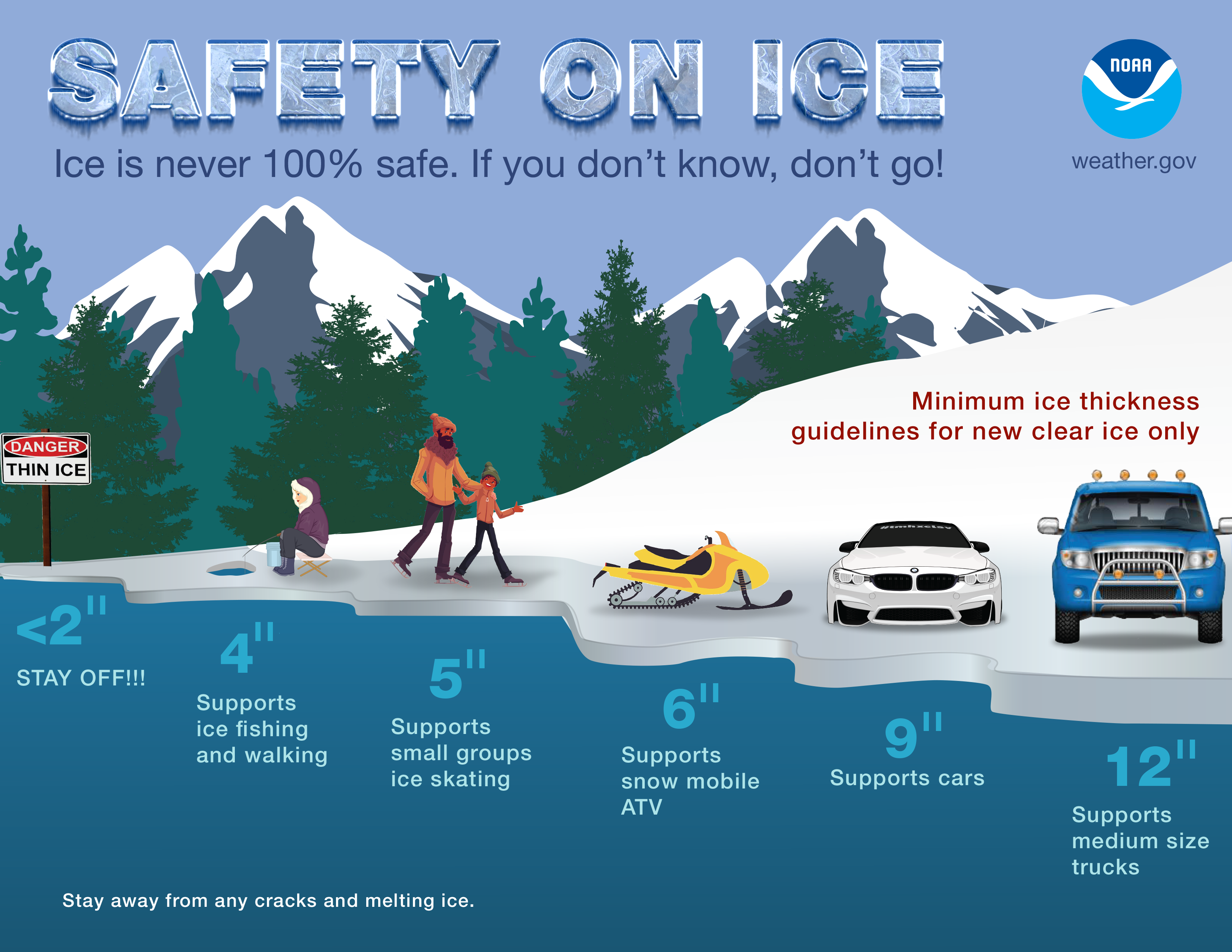
Facebook
Bundling up and staying dry are two of the best things you can do to stay safe from cold temperatures this fall and winter. Learn to protect yourself from the cold at weather.gov/safety/cold
Twitter
Bundling up and staying dry are two of the best things you can do to stay safe from cold temps. Stay #WeatherReady and learn to protect yourself from the cold at weather.gov/safety/cold
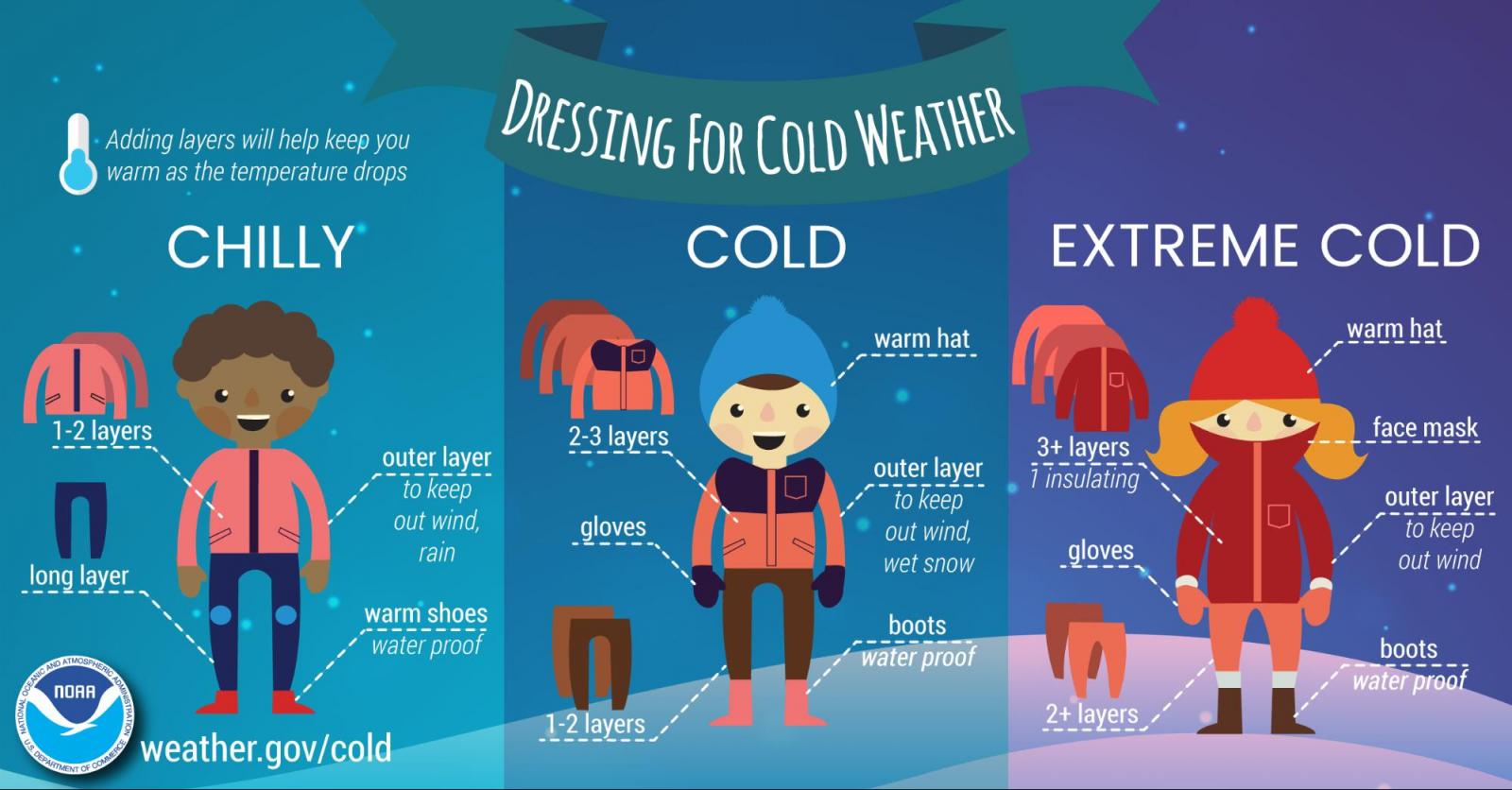
Facebook
If you notice someone exhibiting warning signs of hypothermia, get them to a warm place right away. Learn more about how to protect yourself from the cold at weather.gov/safety/cold
Twitter
Do you know the signs of hypothermia? weather.gov/safety/cold #WeatherReady
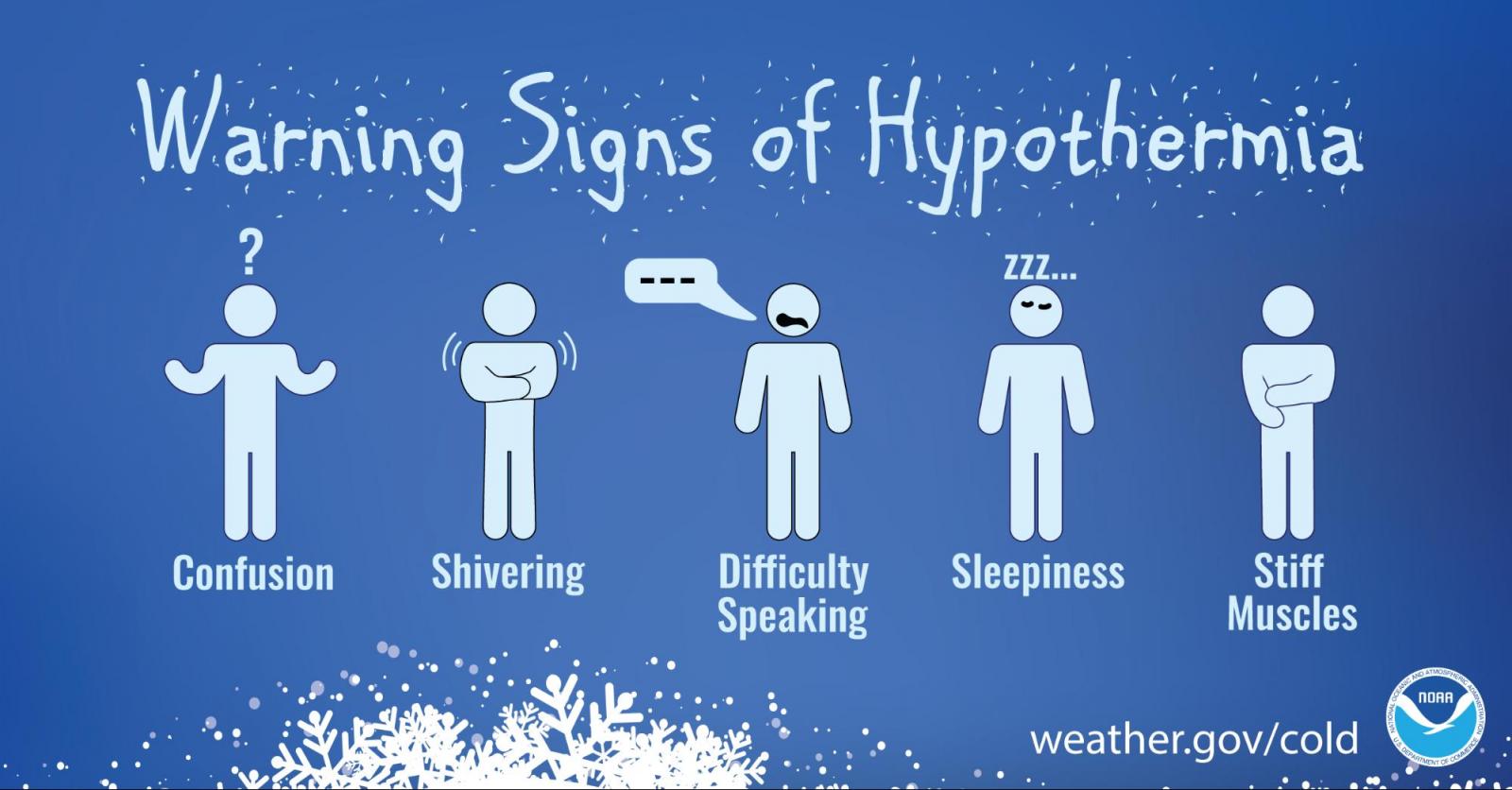
Facebook
Cold weather can be life-threatening. If you can’t avoid being outside, remember to follow these 3 steps and make sure to always tell someone where you’re going. weather.gov/safety/cold
Twitter
Cold weather can be life-threatening, so follow these 3 steps and make sure to always tell someone where you’re going. weather.gov/safety/cold #WeatherReady
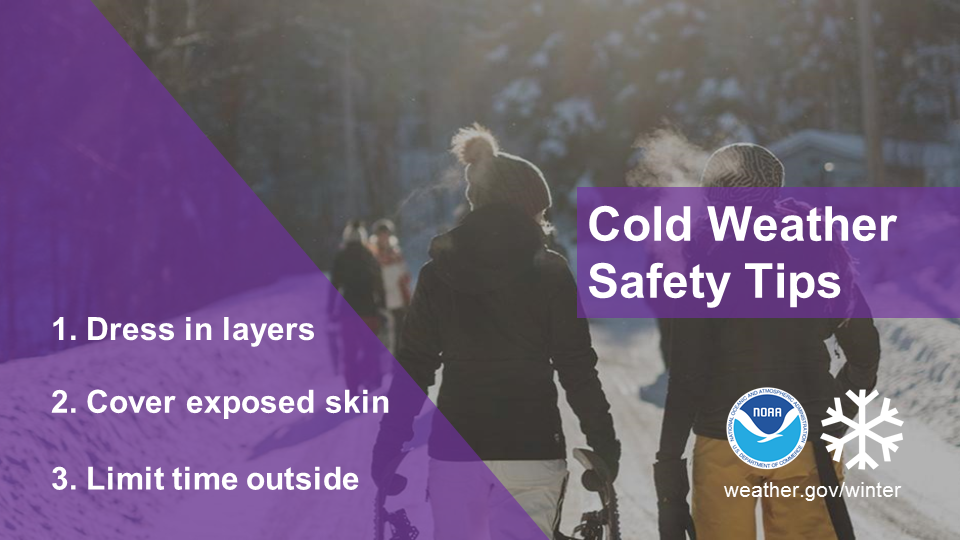
Facebook
Extremely cold air affects millions of people across the United States every winter and even into parts of the spring. This Arctic air, together with brisk winds, can lead to dangerously cold wind chill values, which can cause your body to lose heat quickly. weather.gov/safety/cold-wind-chill-chart
Twitter
Arctic air, together with brisk winds, can lead to dangerously cold wind chill values. weather.gov/safety/cold-wind-chill-chart
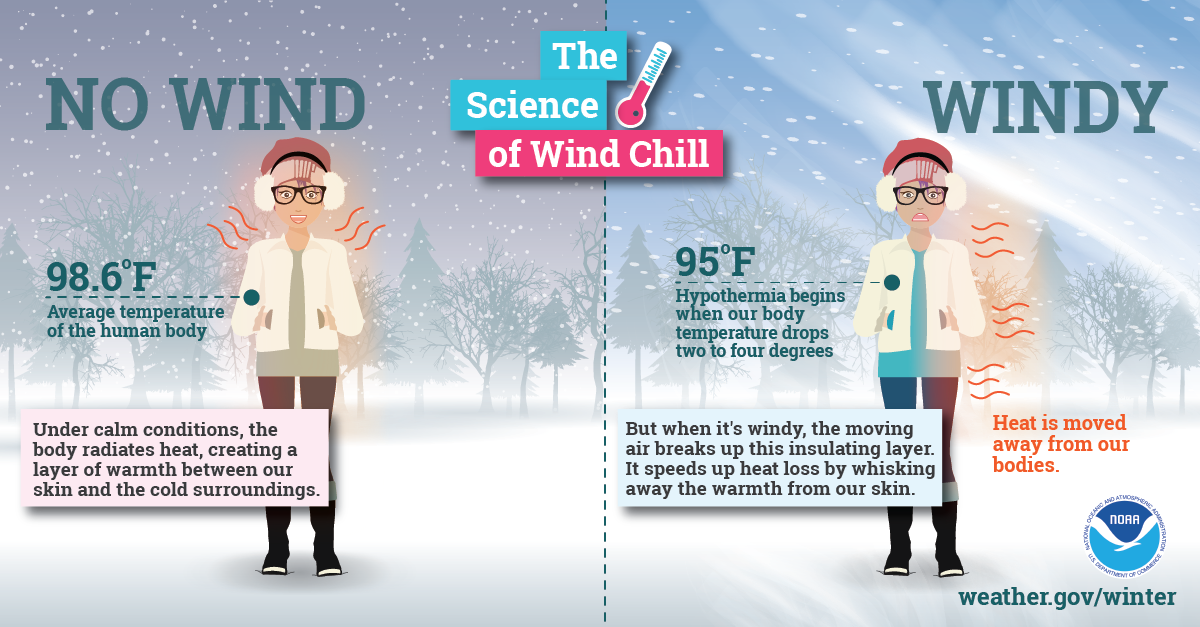
Facebook
Not many winter storms have the potential to bury 100 million people in 1-2 feet of snow in a single day. Nor’easters are notorious for packing strong winds and copious amounts of moisture they get from the Atlantic. The heavily-populated region between Washington D.C., Philadelphia, New York City, and Boston -- the “I-95 Corridor” -- is especially impacted by Nor’easters. weather.gov/safety/winter-noreaster
Twitter
Nor’easters are notorious for big wind and copious amounts of moisture they get from the Atlantic. weather.gov/safety/winter-noreaster #WeatherReady
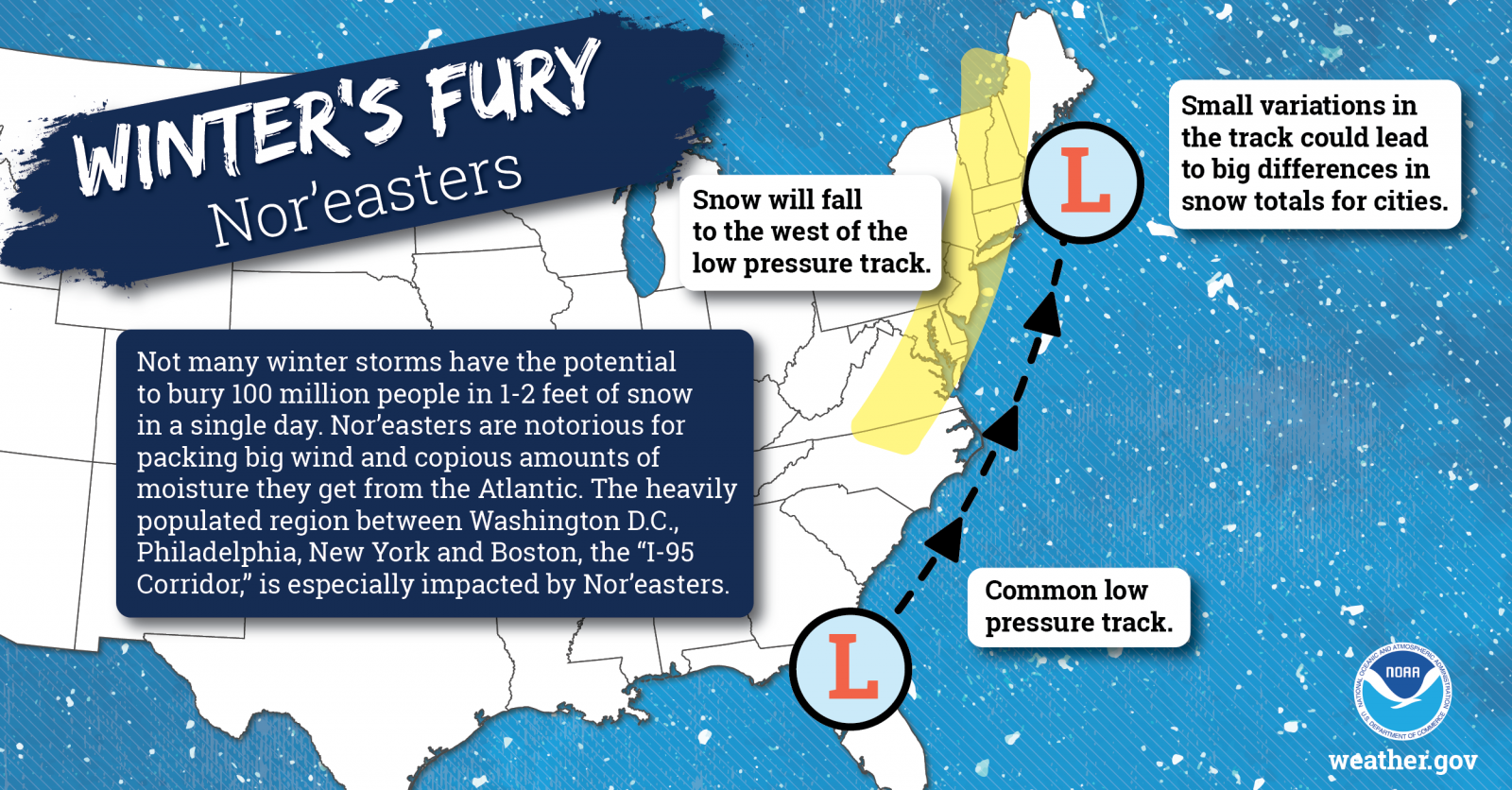
Facebook
Will there be rain, ice, or snow? This graphic explains how having different layers of warm and cold air between the clouds and the ground determines the type of precipitation that hits the ground. nssl.noaa.gov/education/svrwx101/winter/types/
Twitter
Will there be rain, ice, or snow? Find out how wintry precipitation forms! nssl.noaa.gov/education/svrwx101/winter/types/
